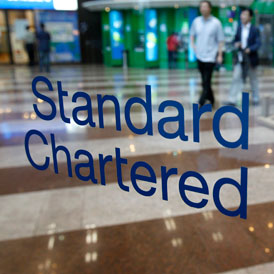Standard Chartered to pay $340m fine
Standard Chartered agrees to pay $340m to settle allegations that it hid transactions with Iran from regulators. But did the bank get off lightly? Analysis from Business Correspondent Sarah Smith.

As transatlantic fights go, the punch-up between Britain’s 160-year-old Standard Chartered Bank (SCB) and America’s 42-year-old New York State Department of Financial Services promised to be a heavyweight affair.
The bank was ordered to appear before the regulator for a hearing that threatened to decide its future in the key US market.
Ex-prosecutor Benjamin Lawsky – aka Benjamin “long arm of the” Lawsky – had threatened to suspend SCB’s New York licence if the bank did not satisfactorily explain “apparent violations of the law”. He portrayed bankers as the greedy, money laundering scourge of Wall Street who hid 60,000 “secret” Iranian transactions.
On Tuesday SCB agreed to pay $340m to settle the allegations.
In addition to the civil penalty, the bank agreed to install a monitor for at least two years to evaluate the bank’s money-laundering risk controls in its New York branch.
“The parties have agreed that the conduct at issue involved transactions of at least $250bn,” the department said in a statement.
The announcement came after Standard Chartered’s Chief Executive Peter Sands, who strongly denied the allegations last week, flew to New York to take personal control of the bank’s attempts to reach a settlement.

‘Clever media relations’
Mr Lawsky’s allegations, colourfully detailed in a 27-page legal order published online on 6 August, reportedly blindsided the bank, federal US and UK regulators, and shareholders. Condemnation of Mr Lawsky’s actions followed swiftly.
Standard Chartered has denied the allegations, however, saying that only a small number of Iranian transactions were mishandled. The bank said the total amount that did not adhere to US sanction laws was less than $14m.
Mr Barofsky calls SCB’s handling of the situation nothing more than clever media relations, however. “It is a PR move. God knows how much they are spending a day trying to blunt this,” he said. Both sides have stong reasons to keep the arguing behind closed doors.
The New York regulator also has reason to keep a low profile, however, preferring not to risk further damaging the bank and its reputation without air-tight evidence.